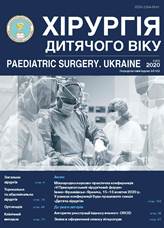Analysis of reasons for dissemination of destructive forms of acute apendicitis in children
DOI:
https://doi.org/10.15574/PS.2020.67.43Keywords:
appendicitis, destructive forms, childrenAbstract
The aim of the study to determine the main causes of destructive forms of acute appendicitis (AA) based on the analysis of quantitative characteristics of the pathology in children of Vinnytsia region in the period from 2005 to 2018.
Materials and methods. To implement the study, a retrospective analysis of 980 medical records of patients treated at the Vinnytsia Regional Clinical Hospital with destructive forms of AA in the period 2005-2018. The age of children was from 1.5 to 18 years.
Results. The results of research show that the destructive forms of appendicitis more frequently affect the boys, especially the junior school age. The reason for the late detection of AA is self-medication and errors in diagnosis. Most patients refered to medical help for the first 2 days after beginning of abdominal pain. In the structure of complications predominated: local peritonitis, omenitis and typhlitis.
Conclusions. It is necessary to pay attention to the availability of medical care to the population, especially in rural areas, to hold sanitary and educational work, and more widely use instrumental methods such as ultrasound diagnostic and computed topography of the abdominal cavity.
The research was carried out in accordance with the principles of the Helsinki Declaration. The study protocol was approved by the Local Ethics Committee of participating institution. The informed consent of the patient was obtained for conducting the studies.
References
Barsukova IM, Gavschuk MV, Krivov AP. (2018). Ostryiy appenditsit: istoriya i sovremennaya organizatsiya meditsinskoy pomoschi. Uchenyie zapiski SPbGMU im. akad. I. P. Pavlova. 25(3); 43–49. https://doi.org/10.24884/1607-4181-2018-25-3-43-49.
Birnbaum BA, Wilson SR. (2000). Appendicitis at the millennium. Radiology. 215(2): 337–348. https://doi.org/10.1148/radiology.215.2.r00ma24337; PMid:10796905
Di Cesare A, Parolini F, Morandi A, Leva E, Torricelli M. (2013). Do we need imaging to diagnose appendicitis in children? African Journal of Paediatric Surgery. 10(2): 68. https://doi.org/10.4103/0189-6725.115024; PMid:23860049
Ivanko OV, Kalyna RA. (2014) Problemy ta napriamy suchasnoho likuvannia hostroho apendytsytu. Khirurhiia Ukrainy. 3; 100–104.
Levin MD. (2016) K patogenezu ostrogo appenditsita. Nespetsificheskaya reaktsiya pischevaritelnogo trakta na ostroe vospalenie v bryushnoy polosti. Eksperimentalnaya i
klinicheskaya gastroenterologiya. 132(8); 67–74.
Losiev OO, Melnychenko MH, Dilanian IR, Samofalov DO. (2011). Pediatric surgery. Navch. posibnyk. – Odesa: ODMedU: 224.
Mattei P. (Ed.). (2017). Fundamentals of pediatric surgery. Springer Science & Business Media: 935.
Peter M, Peter FN, Michael DR, Christopher SM. (2017). Fundamentals of Pediatric Surgery. – Switzerland: Springer: 935.
Podkamenev VV. (2018). Neotlozhnaya abdominalnaya hirurgiya detskogo vozrasta. – M.: Izd. gruppa «GEOTARMedia»: 208.
Razin MP, Strelkov NS, Skobolev VA, Galkin VN. (2012). Osnovyi gnoynoy hirurgii detskogo vozrasta. -M.: ID «Medpraktika-M»: 148.
Sinenchenko GI, Kuryigina AA, Bagnenko SF. (2009). Hirurgiya ostrogo zhivota.-SPb: 512.
Sovtsov SA. (2016). Letopis chastnoy hirurgii Chast. Appenditsit Monografiya. – Chelyabinsk: 199.
Downloads
Published
Issue
Section
License
The policy of the Journal “PAEDIATRIC SURGERY. UKRAINE” is compatible with the vast majority of funders' of open access and self-archiving policies. The journal provides immediate open access route being convinced that everyone – not only scientists - can benefit from research results, and publishes articles exclusively under open access distribution, with a Creative Commons Attribution-Noncommercial 4.0 international license(СС BY-NC).
Authors transfer the copyright to the Journal “PAEDIATRIC SURGERY.UKRAINE” when the manuscript is accepted for publication. Authors declare that this manuscript has not been published nor is under simultaneous consideration for publication elsewhere. After publication, the articles become freely available on-line to the public.
Readers have the right to use, distribute, and reproduce articles in any medium, provided the articles and the journal are properly cited.
The use of published materials for commercial purposes is strongly prohibited.

